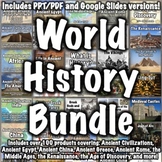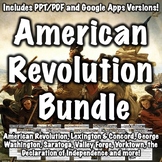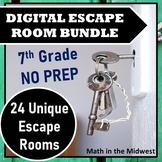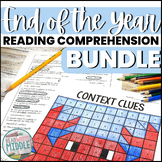28 results
7th grade Native Americans lessons for Easel Activities

Mayas, Incas, Aztecs
Were pre-Columbian peoples civilized? Students will research and analyze documents to determine the characteristics and elements of civilization from the Ancient Incas, Mayans, and Aztecs. They will complete a Venn diagram/compare and contrast application question in this engaging lesson and activity!Included in this resource:• Title page• Do Now/Motivation student-centered question• Ancient Maya reading passage• Ancient Inca reading passage• Ancient Aztec reading passage• Ancient Maya, Inca,
Grades:
5th - 8th
Also included in: Native Americans UNIT BUNDLE with BONUS Activities

Westward Expansion: Homestead Act of 1862 and Native Americans
Students will read and answer text dependent questions how the Homestead Act of 1862 and how westward expansion impacted the settlers and the Native Americans. They will have a variety of activities involving vocabulary activities, primary source analysis, writing prompts, and informational text to evaluate the struggles and impact of westward expansion.
Grades:
4th - 8th
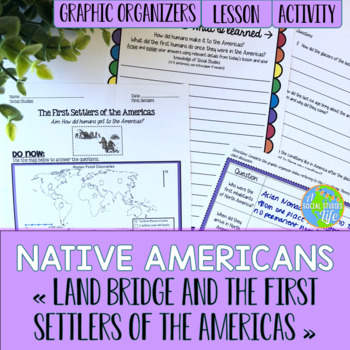
Native Americans - Land Bridge and the First Settlers of the Americas
How did humans get to the Americas? Students will research how the first humans reached the Americas by the Land Bridge Theory and use their research and analysis of the document to answer scaffolding questions and complete the graphic organizer in this engaging lesson and activity!Included in this resource:• Title page• Do Now/Motivation student-centered map-skills questions• The Land Bridge reading passage with scaffolding questions• The Land Bridge graphic organizer• Application/Closing/High
Grades:
5th - 8th
Also included in: Native Americans UNIT BUNDLE with BONUS Activities
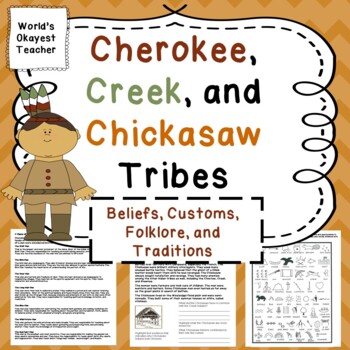
Cherokee, Creek, and Chickasaw: Customs, Beliefs, and Traditions
Students will read and answer text dependent questions about the beliefs, customs, folklore, and traditions of the Cherokee, Creek, and Chickasaw tribes. There is also reading material on the 7 Clans of the Cherokee with a fun writing assignment. Native American symbols are also provided for a rebus activity where students can use their imagination to write a story with words and symbols.
Subjects:
Grades:
3rd - 8th
Types:
Also included in: BIG Tennessee History Bundle
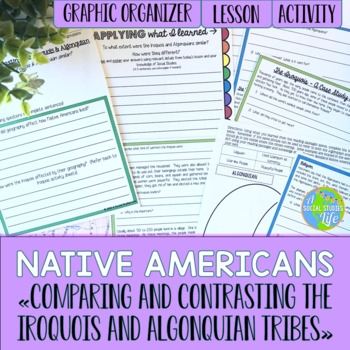
Iroquois and Algonquian Native Americans
How were the Iroquois & Algonquian similar? Students will research & analyze the similarities and differences between the Iroquois & Algonquian Native Americans living in the Northeast region of present-day United StatesIncluded in this resource:• Title page• Do Now/Motivation student-centered questions• Map of Native American tribes in New York, USA• The Algonquians: A Case Study of Culture reading passage with scaffolding questions• The Iroquois: A Case Study of Culture reading pa
Grades:
5th - 8th
Also included in: Native Americans UNIT BUNDLE with BONUS Activities
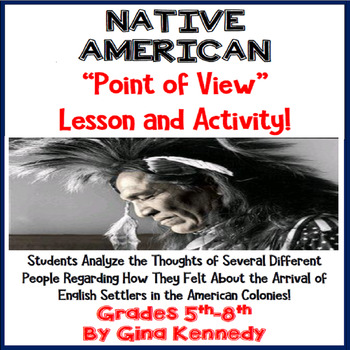
Native American Point of View Reading and Writing Project
No-prep, Native American "point of view" reading lesson! After reading passages, and actual letters and statements from Native Americans, students use critical reading skills to show their understanding of the points of view of many Native Americans and others today. A difficult part of American history is the loss of Native American land to the English settlers. This lesson provides an opportunity for your students to take an in depth look at the opinions of several Native Americans and othe
Grades:
5th - 8th

Residential School Mini Unit with Lessons & Activities for Elementary and Middle
This Indigenous (Aboriginal, First Peoples, First Nations) residential school mini unit is a meaningful printable package that blends Canadian residential school history lessons with engaging activities. This mini unit is intended for elementary intermediate students, and middle school students (Grades 3-8).This resource is digital ready and can be easily assigned for distance learning through Google ClassroomTM.What You Get:1 Informational Page1 Booklet Title Page5 ActivitiesThis resource can b
Grades:
3rd - 8th

Iroquois Confederacy
Why did the Iroquois form a confederacy? Students will research how and why the 5 Iroquois tribes formed a union. They will agree or disagree with the policies of the confederacy and explain why or why not and suggest new policies if in disagreement in this engaging lesson and activity!Included in this resource:• Title page• Do Now/Motivation student-centered question• Problems & Solutions graphic organizer• The League of the Iroquois Policies Document• The Iroquois League Graphic Organize
Grades:
5th - 8th
Also included in: Native Americans UNIT BUNDLE with BONUS Activities
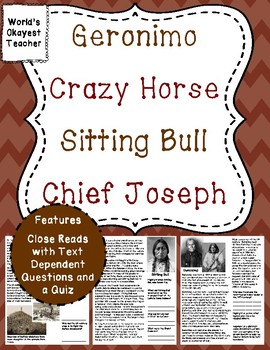
Native American Leaders: Crazy Horse, Sitting Bull, Geronimo, and Chief Joseph
Students will read and answer text dependent questions about the significance of Native American leaders including; Sitting Bull, Crazy Horse, Geronimo, and Chief Joseph. There is a quiz included.
Grades:
4th - 8th
Types:
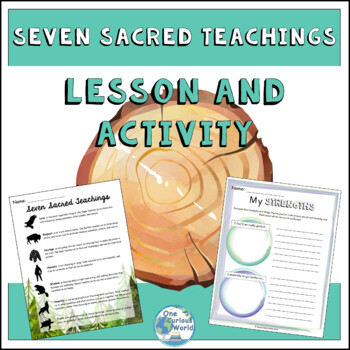
Seven Sacred Teachings Introduction Lesson & Activity
This Indigenous (Aboriginal, First Peoples, First Nations) lesson is a meaningful printable activity that blends the Seven Sacred Teachings, also known as the Seven Grandfather Teachings, with Social Emotional Learning (SEL).This supplemental resource engages students to explore the Indigenous values of love, respect, honesty, humility, courage, wisdom, and truth.What You Get:One Informational Overview LessonOne ActivityPlease note that this lesson and activity are part of the Seven Sacred Teach
Grades:
2nd - 8th
Types:

Paleo, Archaic, Woodland, Mississippian People
Students will learn about the prehistoric people that inhabited the southeastern United States. They will read, compare and contrast, highlight important information, and answer questions about the Paleo, Archaic, Woodland, and Mississippian people. Information on the Coates-Hines site, the Pinson Mounds, and the Chucalissa Village are also included. There is a fill in the blank quiz and a matching activity that can be used as assessments.
Grades:
3rd - 8th
Types:
Also included in: BIG Tennessee History Bundle
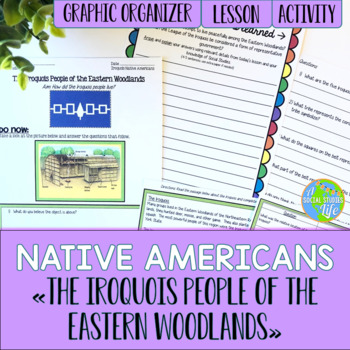
Iroquois Native Americans
How did the Iroquois people live? Students will research how the Iroquois lived: location, tribes, homes, adaptation based on environment, role of women, League of Five Nations, Hiawatha Wampum Belt - in this engaging lesson and activity!Included in this resource:• Title page• Do Now/Motivation student-centered questions based on document• The Iroquois reading passage with graphic organizer• The Hiawatha Wampum Belt reading passage with scaffolding questions• Application/Closing/Higher Order Th
Grades:
5th - 8th
Also included in: Native Americans UNIT BUNDLE with BONUS Activities

FREE Orange Shirt Day Residential School Art Activity in French and English
This Indigenous (Aboriginal, First Peoples, First Nations) Orange Shirt Day FREEBIE reflects on residential school history, and could be used as a stand alone activity for Orange Shirt Day (L’histoire du chandail orange), or as a supplemental activity for National Indigenous Peoples Day (formerly known as Aboriginal Day). This resource includes both English and French versions.What you get:" Every Child Matters " Art project "I Matter Because I Am..." Art Project" Chaque enfant compte " Art Proj
Grades:
K - 8th
Types:
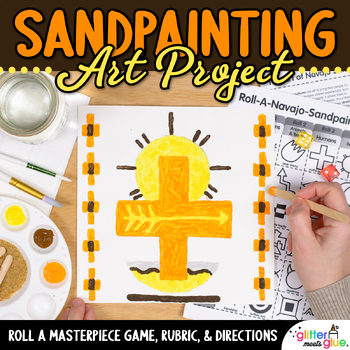
Navajo Sand Painting Art Project: Exit Slips, Art Sub Plan, & Reflection Rubrics
Ready to ignite your elementary art curriculum with engaging, no prep multicultural art projects? This Navajo sand painting art lesson will boost confidence and creativity. Kids will enjoy learning about the traditions and customs of why sand paintings are made. Moreover, they’ll appreciate the difficulty in creating them.And, it’ll help time-starved teachers like you create art lesson plans based on the rich history of the Navajo and Pueblo people. During this art project, your class will learn
Subjects:
Grades:
4th - 7th

Native Americans Southeast, Great Basin, Plateau, Northwest Coast Regions
How did Native Americans of various cultural regions live? Students will research & analyze the culture and adaptations of American Indians of the Northwest Coast, Plateau, Southeast, & Great Basin Regions: climate, food, shelter, transportation, ceremonies/ritualsIncluded in this resource:• Title page• Do Now/Motivation student-centered questions• Document Pass Activity - Reading passages/documents on Northwest Coast Region, Great Basin, Plateau & Southeast Regions• Graphic Organiz
Grades:
5th - 8th
Also included in: Native Americans UNIT BUNDLE with BONUS Activities
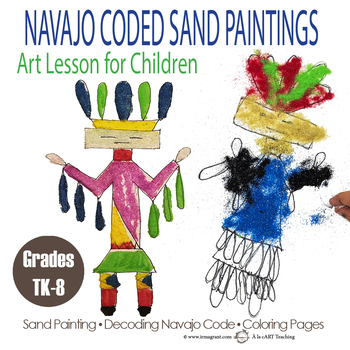
Navajo Coded Sand Painting: Art Lesson for Kids
This à la cART lesson introduces students to Navajo sand painting and the secret Navajo radio code developed during World War 2 to transmit secret messages. They will draw and sand paint a Navajo Yei (figure) and write their name using the secret Navajo code.This lesson includes two copies of the Navajo Code Dictionary:1. Original version2. Censored version where the word "Jackass" for donkey has been changed to "Jenny" a female donkey You will Receive37-page, non-editable PDFvideo instructions
Subjects:
Grades:
PreK - 8th
Types:

Trail of Tears
Students will read about and evaluate the consequences of the Indian Removal Act of 1830. They will learn about the impact of this tragic episode in our history on the Native Americans. They will read primary source documents and answer critical thinking questions. The lesson has excerpts from speeches of past presidents in favor of Native American removal, as well as letters written by soldiers who witnessed it first hand.
Grades:
4th - 8th
Types:
Also included in: BIG Tennessee History Bundle
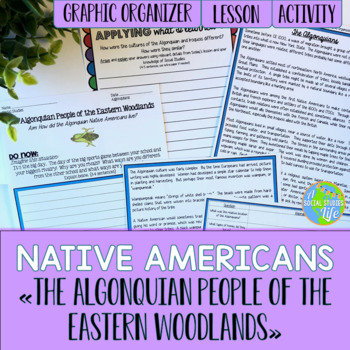
Algonquian Native Americans
How did the Algonquian people live? Students will research how the Algonquian lived: location, tribes, homes, adaptation based on environment, role of women - in this engaging lesson and activity!Included in this resource:• Title page• Do Now/Motivation student-centered question• The Algonquian reading passage with graphic organizer• Application/Closing/Higher Order Thinking Question• Answer Key for Graphic Organizer• Interactive Notebook notes pages Adheres to Social Studies Common Core Standa
Grades:
5th - 8th
Also included in: Native Americans UNIT BUNDLE with BONUS Activities

Territory South of the River Ohio: Tennessee History
Students will read, highlight, underline, and answer text dependent questions on the Territory South of the River Ohio. The product features information about William Blount, the Treaty of Holston, John Sevier, Rocky Mount, and the State of Franklin.
Subjects:
Grades:
4th - 8th
Types:
Also included in: BIG Tennessee History Bundle
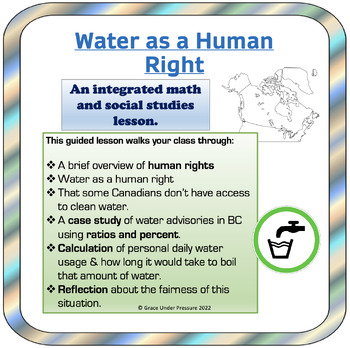
Clean Water - Human Rights: Math & SS Current Events Lesson & Worksheet (Canada)
Why doesn't everyone in Canada have access to clean, drinkable water? This 3-page guided lesson walks your students in grades 5-8 through important current events issues that affect citizens of Canada every day. It includes: - A brief overview of human rights including the United Nation Declaration of Human Rights. - An introduction to the idea of water as a human right. - That some Canadians (especially in indigenous communities) don’t have access to clean water. - A case study of water advisor
Grades:
5th - 8th
Types:
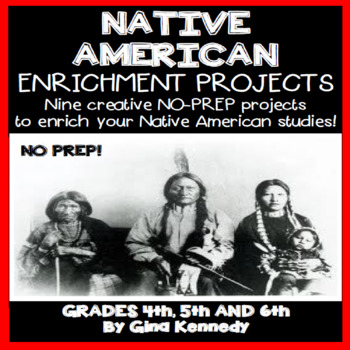
Native American Projects, Writing and Research Activities
NO-PREP! Teacher friendly Native American enrichment projects that will challenge your student to think out of the box while creating fun and brilliant projects. From creating a map, writing a compare and contrast paper or even becoming a real estate agent for the Native Americans, your students will love these no-prep; but fun projects to display their knowledge of the history of Native Americans and the Native American culture.Included with this resource:Nine fun, creative projects!Better Ex
Grades:
4th - 8th

Native Americans Characteristics of a Civilization
Why did civilizations develop? Students will research and analyze documents to determine the five characteristics of a civilization in a cooperative setting, they can participate in whole-group discussion on the five characteristics of a civilization in this engaging lesson and activity!Included in this resource:• Title page • Do Now/Motivation student-centered question• Characteristics of a Civilization Station Activity• Documents for Station Activity• Five Characteristics Graphic Organizer• A
Grades:
5th - 9th
Also included in: Native Americans UNIT BUNDLE with BONUS Activities

Southwest Native Americans
How did the Native Americans of the Southwest region live? Students will research and analyze the lives and culture of the Native Americans of the Southwest region of the United States: present-day areas, groups, geography/climate, adaptations, cultures/spiritual rituals/roles of men and womenIncluded in this resource:• Title page• Native Americans of the Southwest reading passage with graphic organizer• Application/Closing/Higher Order thinking question• Answer Key for graphic organizer• Inter
Grades:
5th - 8th
Also included in: Native Americans UNIT BUNDLE with BONUS Activities
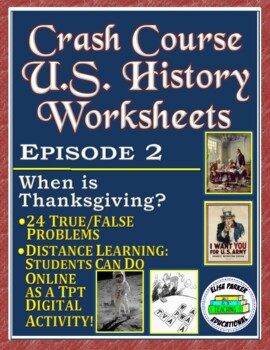
Crash Course U.S. History Worksheet: Episode 2 -- When is Thanksgiving?
24 True/False Problems in video order and provided both with and without time stamps! Includes both a one-page worksheet as well as a large-format version with plenty of room for student answers! Perfect for distance learning -- can be done fully online as a digital activity! Makes it easy for American history classes to step outside the textbook and use highly engaging video content!PERFECT FOR DISTANCE LEARNING OR A PAPERLESS CLASSROOM:Can be completed by students fully online, using any devic
Subjects:
Grades:
6th - 11th
Types:
Showing 1-24 of 28 results


